Human Resource Metrics: Leadership Change and Implementation Report
VerifiedAdded on 2020/05/16
|6
|825
|126
Report
AI Summary
This report examines human resource metrics through the lens of leadership change, using Anne Mulcahy's leadership at Xerox as a case study. It analyzes her approach during a crisis, highlighting her democratic leadership style, focus on employee intuition, and emphasis on communication. The report identifies three critical components for implementing change: communication, collaboration, and commitment (the 3 C's). Successful leaders effectively communicate the 'why' behind changes, foster collaboration across boundaries, and demonstrate personal commitment to the change process. The report contrasts these with the pitfalls of unsuccessful leadership, offering valuable insights into effective change management strategies for organizations. This report is a student submission available on Desklib, a platform offering AI-powered study tools and resources.
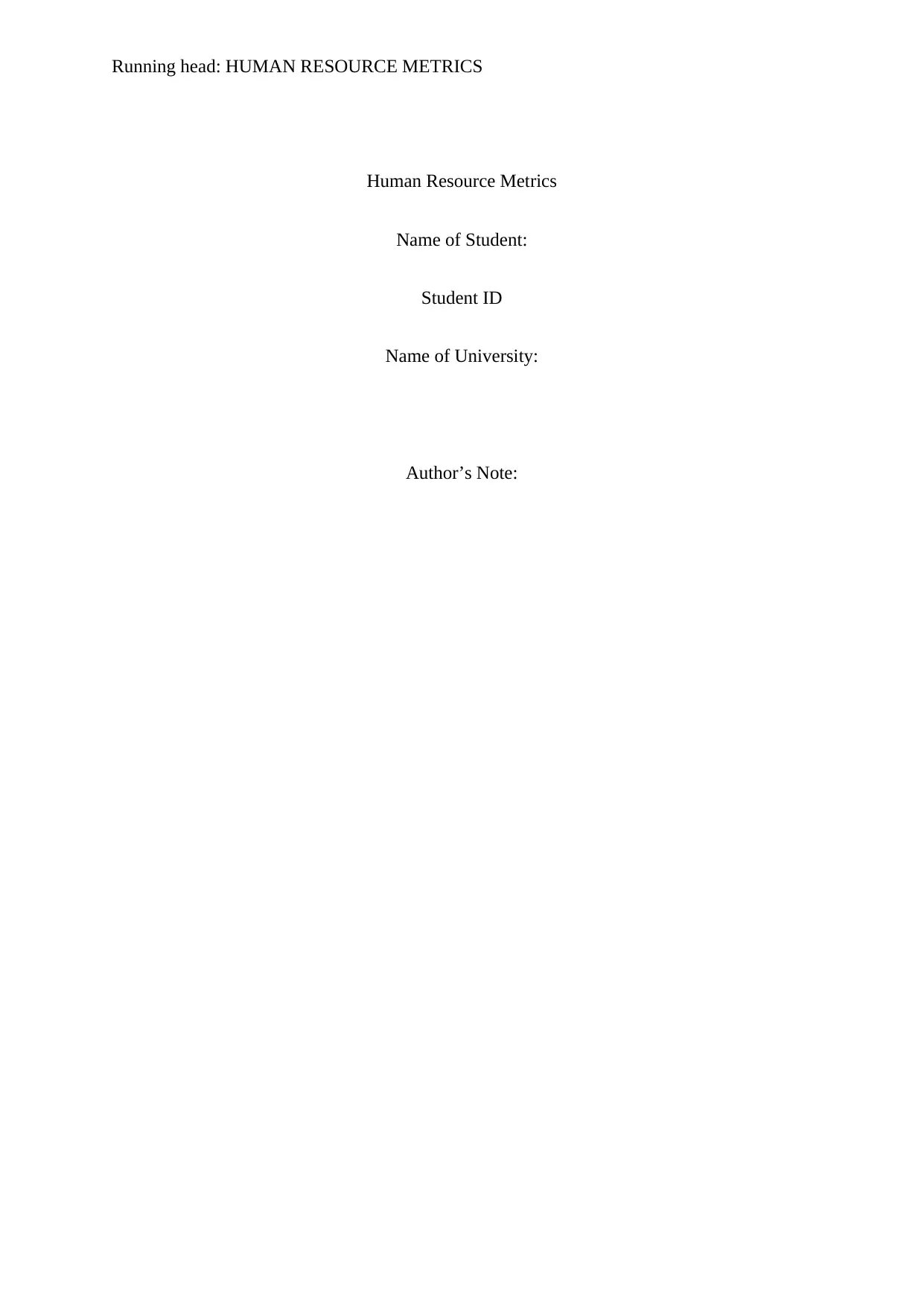
Running head: HUMAN RESOURCE METRICS
Human Resource Metrics
Name of Student:
Student ID
Name of University:
Author’s Note:
Human Resource Metrics
Name of Student:
Student ID
Name of University:
Author’s Note:
Paraphrase This Document
Need a fresh take? Get an instant paraphrase of this document with our AI Paraphraser
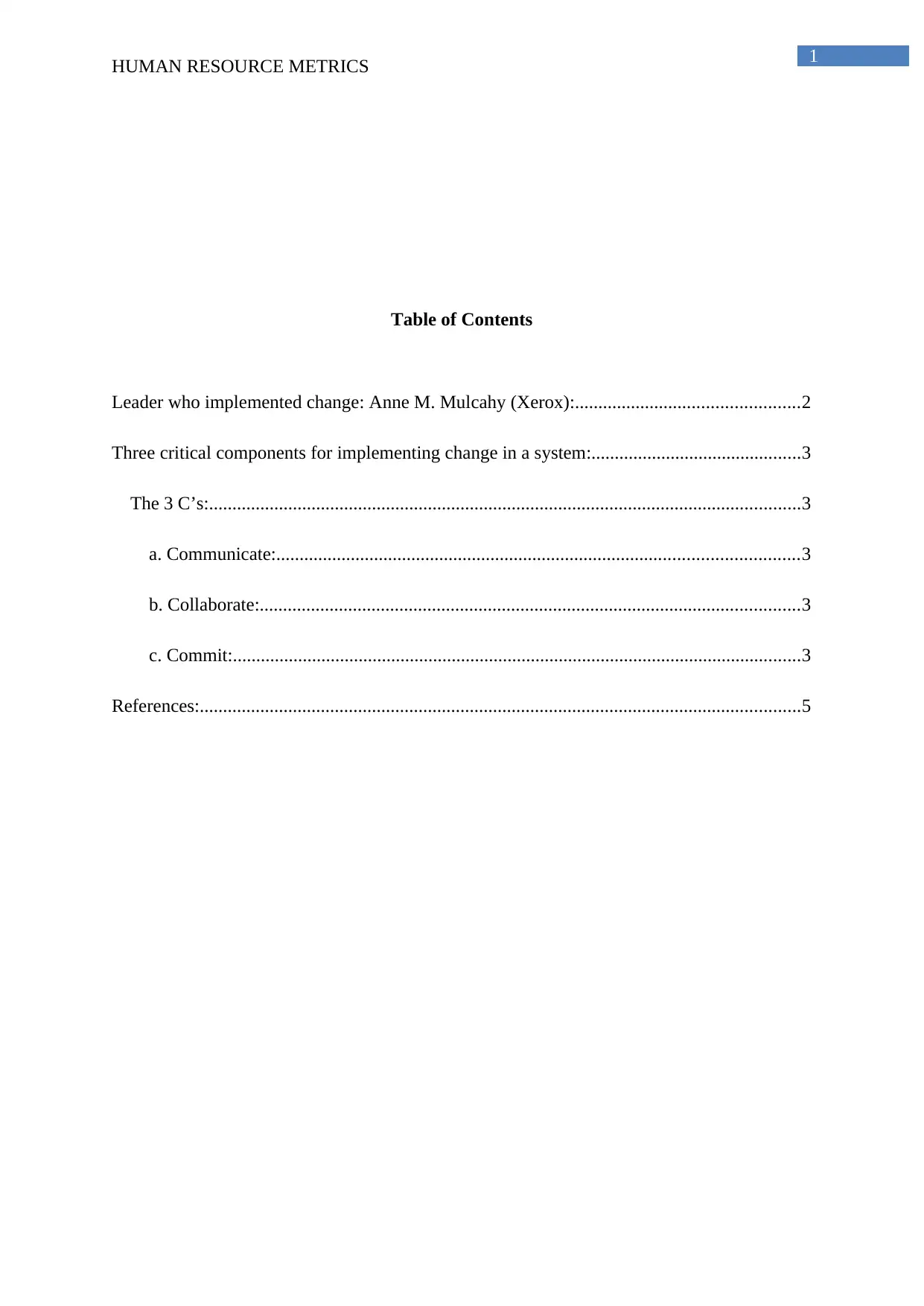
1
HUMAN RESOURCE METRICS
Table of Contents
Leader who implemented change: Anne M. Mulcahy (Xerox):................................................2
Three critical components for implementing change in a system:.............................................3
The 3 C’s:...............................................................................................................................3
a. Communicate:................................................................................................................3
b. Collaborate:....................................................................................................................3
c. Commit:..........................................................................................................................3
References:.................................................................................................................................5
HUMAN RESOURCE METRICS
Table of Contents
Leader who implemented change: Anne M. Mulcahy (Xerox):................................................2
Three critical components for implementing change in a system:.............................................3
The 3 C’s:...............................................................................................................................3
a. Communicate:................................................................................................................3
b. Collaborate:....................................................................................................................3
c. Commit:..........................................................................................................................3
References:.................................................................................................................................5
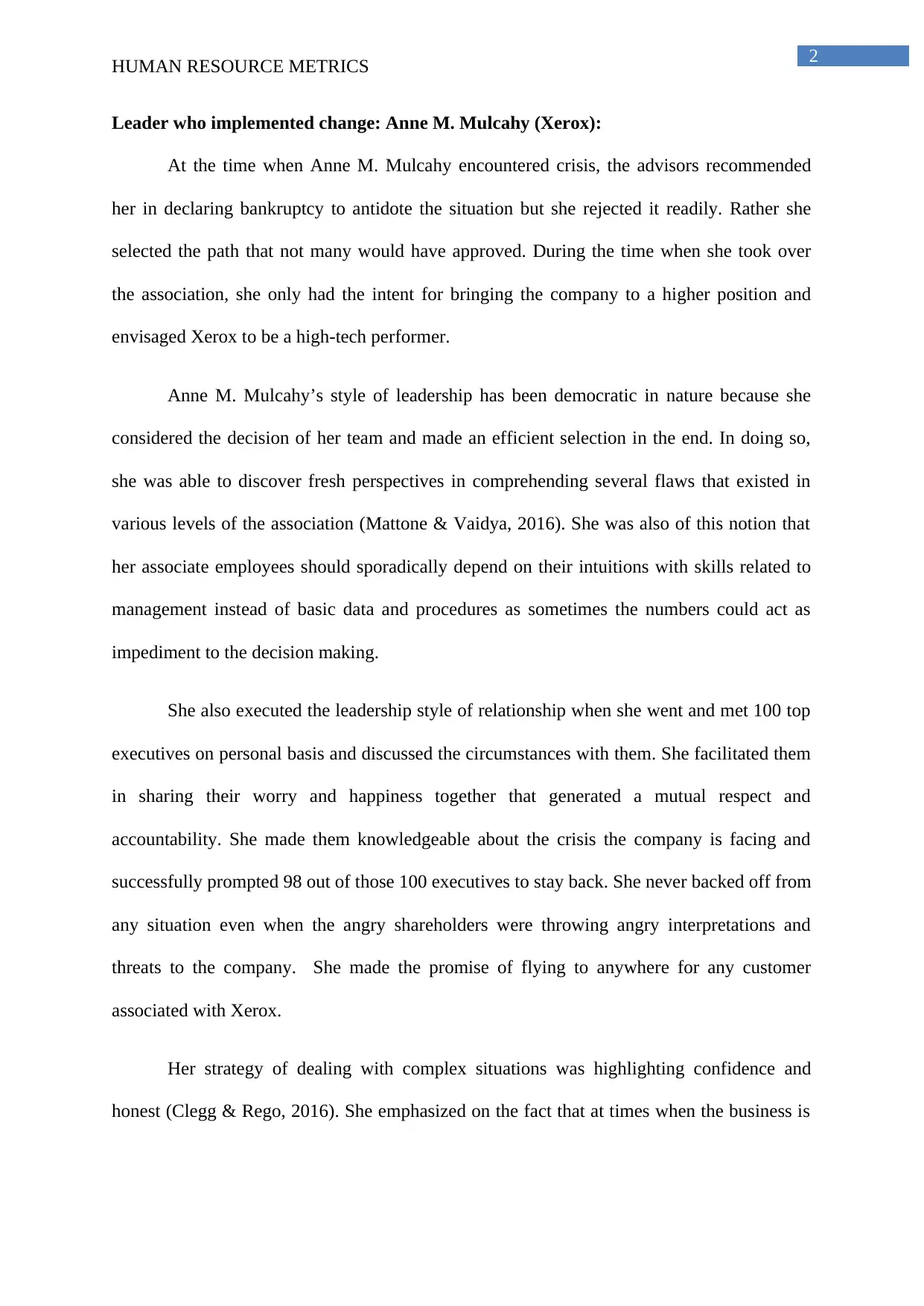
2
HUMAN RESOURCE METRICS
Leader who implemented change: Anne M. Mulcahy (Xerox):
At the time when Anne M. Mulcahy encountered crisis, the advisors recommended
her in declaring bankruptcy to antidote the situation but she rejected it readily. Rather she
selected the path that not many would have approved. During the time when she took over
the association, she only had the intent for bringing the company to a higher position and
envisaged Xerox to be a high-tech performer.
Anne M. Mulcahy’s style of leadership has been democratic in nature because she
considered the decision of her team and made an efficient selection in the end. In doing so,
she was able to discover fresh perspectives in comprehending several flaws that existed in
various levels of the association (Mattone & Vaidya, 2016). She was also of this notion that
her associate employees should sporadically depend on their intuitions with skills related to
management instead of basic data and procedures as sometimes the numbers could act as
impediment to the decision making.
She also executed the leadership style of relationship when she went and met 100 top
executives on personal basis and discussed the circumstances with them. She facilitated them
in sharing their worry and happiness together that generated a mutual respect and
accountability. She made them knowledgeable about the crisis the company is facing and
successfully prompted 98 out of those 100 executives to stay back. She never backed off from
any situation even when the angry shareholders were throwing angry interpretations and
threats to the company. She made the promise of flying to anywhere for any customer
associated with Xerox.
Her strategy of dealing with complex situations was highlighting confidence and
honest (Clegg & Rego, 2016). She emphasized on the fact that at times when the business is
HUMAN RESOURCE METRICS
Leader who implemented change: Anne M. Mulcahy (Xerox):
At the time when Anne M. Mulcahy encountered crisis, the advisors recommended
her in declaring bankruptcy to antidote the situation but she rejected it readily. Rather she
selected the path that not many would have approved. During the time when she took over
the association, she only had the intent for bringing the company to a higher position and
envisaged Xerox to be a high-tech performer.
Anne M. Mulcahy’s style of leadership has been democratic in nature because she
considered the decision of her team and made an efficient selection in the end. In doing so,
she was able to discover fresh perspectives in comprehending several flaws that existed in
various levels of the association (Mattone & Vaidya, 2016). She was also of this notion that
her associate employees should sporadically depend on their intuitions with skills related to
management instead of basic data and procedures as sometimes the numbers could act as
impediment to the decision making.
She also executed the leadership style of relationship when she went and met 100 top
executives on personal basis and discussed the circumstances with them. She facilitated them
in sharing their worry and happiness together that generated a mutual respect and
accountability. She made them knowledgeable about the crisis the company is facing and
successfully prompted 98 out of those 100 executives to stay back. She never backed off from
any situation even when the angry shareholders were throwing angry interpretations and
threats to the company. She made the promise of flying to anywhere for any customer
associated with Xerox.
Her strategy of dealing with complex situations was highlighting confidence and
honest (Clegg & Rego, 2016). She emphasized on the fact that at times when the business is
⊘ This is a preview!⊘
Do you want full access?
Subscribe today to unlock all pages.

Trusted by 1+ million students worldwide
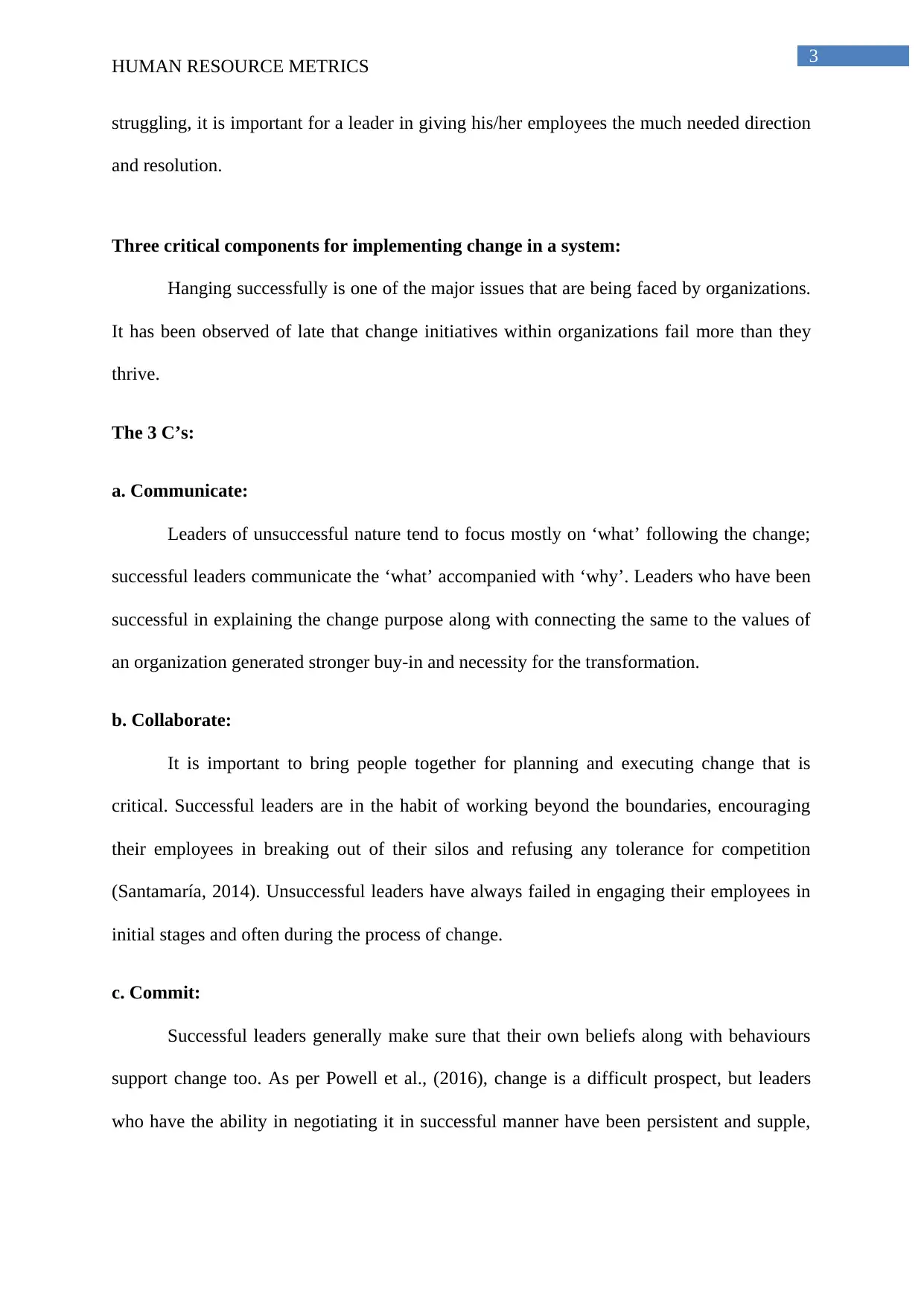
3
HUMAN RESOURCE METRICS
struggling, it is important for a leader in giving his/her employees the much needed direction
and resolution.
Three critical components for implementing change in a system:
Hanging successfully is one of the major issues that are being faced by organizations.
It has been observed of late that change initiatives within organizations fail more than they
thrive.
The 3 C’s:
a. Communicate:
Leaders of unsuccessful nature tend to focus mostly on ‘what’ following the change;
successful leaders communicate the ‘what’ accompanied with ‘why’. Leaders who have been
successful in explaining the change purpose along with connecting the same to the values of
an organization generated stronger buy-in and necessity for the transformation.
b. Collaborate:
It is important to bring people together for planning and executing change that is
critical. Successful leaders are in the habit of working beyond the boundaries, encouraging
their employees in breaking out of their silos and refusing any tolerance for competition
(Santamaría, 2014). Unsuccessful leaders have always failed in engaging their employees in
initial stages and often during the process of change.
c. Commit:
Successful leaders generally make sure that their own beliefs along with behaviours
support change too. As per Powell et al., (2016), change is a difficult prospect, but leaders
who have the ability in negotiating it in successful manner have been persistent and supple,
HUMAN RESOURCE METRICS
struggling, it is important for a leader in giving his/her employees the much needed direction
and resolution.
Three critical components for implementing change in a system:
Hanging successfully is one of the major issues that are being faced by organizations.
It has been observed of late that change initiatives within organizations fail more than they
thrive.
The 3 C’s:
a. Communicate:
Leaders of unsuccessful nature tend to focus mostly on ‘what’ following the change;
successful leaders communicate the ‘what’ accompanied with ‘why’. Leaders who have been
successful in explaining the change purpose along with connecting the same to the values of
an organization generated stronger buy-in and necessity for the transformation.
b. Collaborate:
It is important to bring people together for planning and executing change that is
critical. Successful leaders are in the habit of working beyond the boundaries, encouraging
their employees in breaking out of their silos and refusing any tolerance for competition
(Santamaría, 2014). Unsuccessful leaders have always failed in engaging their employees in
initial stages and often during the process of change.
c. Commit:
Successful leaders generally make sure that their own beliefs along with behaviours
support change too. As per Powell et al., (2016), change is a difficult prospect, but leaders
who have the ability in negotiating it in successful manner have been persistent and supple,
Paraphrase This Document
Need a fresh take? Get an instant paraphrase of this document with our AI Paraphraser

4
HUMAN RESOURCE METRICS
showing willingness to go beyond or step out of their comfort zone. Unsuccessful leaders
have over the years failed to acclimatize with challenges and expressed negativity.
HUMAN RESOURCE METRICS
showing willingness to go beyond or step out of their comfort zone. Unsuccessful leaders
have over the years failed to acclimatize with challenges and expressed negativity.
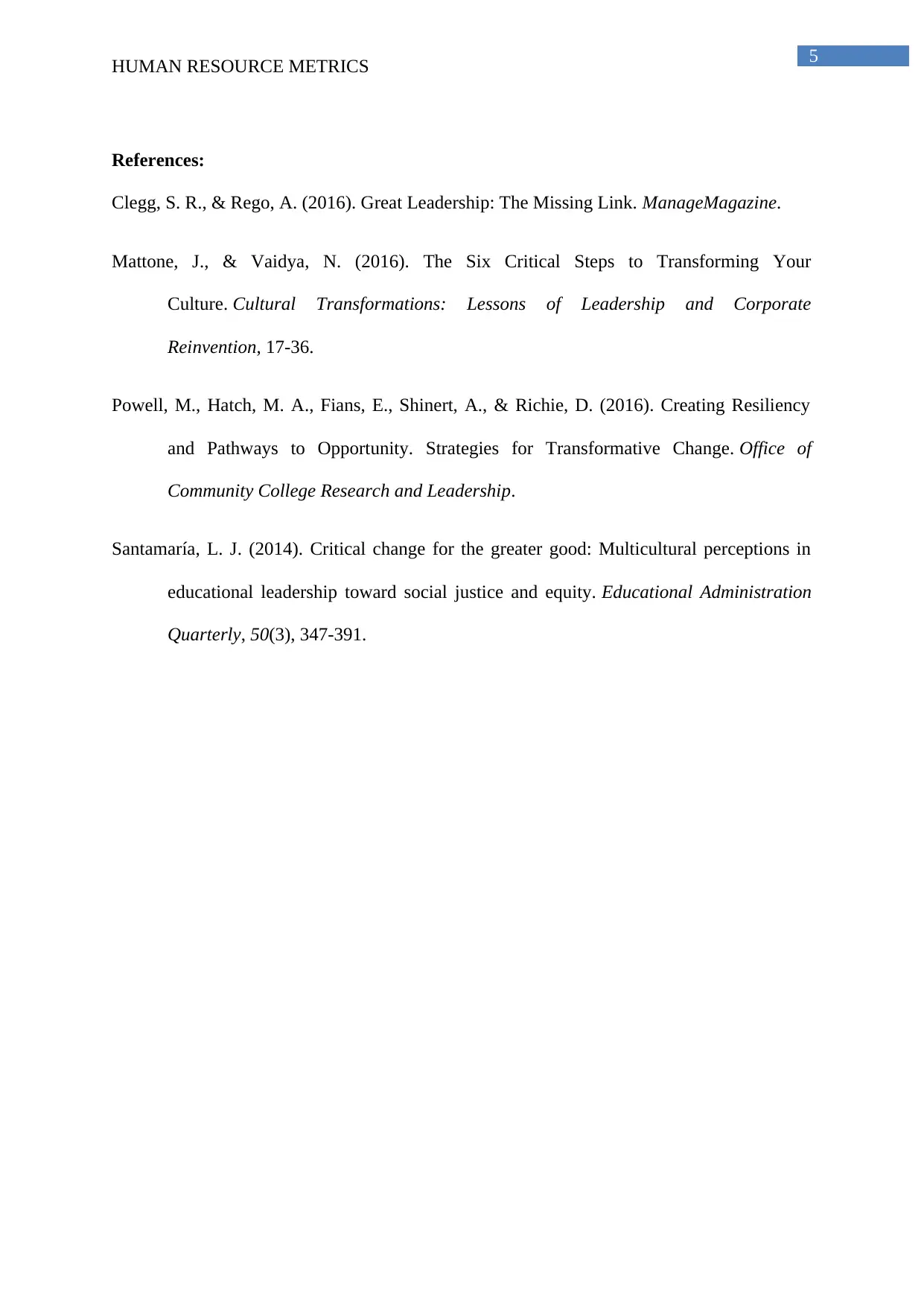
5
HUMAN RESOURCE METRICS
References:
Clegg, S. R., & Rego, A. (2016). Great Leadership: The Missing Link. ManageMagazine.
Mattone, J., & Vaidya, N. (2016). The Six Critical Steps to Transforming Your
Culture. Cultural Transformations: Lessons of Leadership and Corporate
Reinvention, 17-36.
Powell, M., Hatch, M. A., Fians, E., Shinert, A., & Richie, D. (2016). Creating Resiliency
and Pathways to Opportunity. Strategies for Transformative Change. Office of
Community College Research and Leadership.
Santamaría, L. J. (2014). Critical change for the greater good: Multicultural perceptions in
educational leadership toward social justice and equity. Educational Administration
Quarterly, 50(3), 347-391.
HUMAN RESOURCE METRICS
References:
Clegg, S. R., & Rego, A. (2016). Great Leadership: The Missing Link. ManageMagazine.
Mattone, J., & Vaidya, N. (2016). The Six Critical Steps to Transforming Your
Culture. Cultural Transformations: Lessons of Leadership and Corporate
Reinvention, 17-36.
Powell, M., Hatch, M. A., Fians, E., Shinert, A., & Richie, D. (2016). Creating Resiliency
and Pathways to Opportunity. Strategies for Transformative Change. Office of
Community College Research and Leadership.
Santamaría, L. J. (2014). Critical change for the greater good: Multicultural perceptions in
educational leadership toward social justice and equity. Educational Administration
Quarterly, 50(3), 347-391.
⊘ This is a preview!⊘
Do you want full access?
Subscribe today to unlock all pages.

Trusted by 1+ million students worldwide
1 out of 6
Your All-in-One AI-Powered Toolkit for Academic Success.
+13062052269
info@desklib.com
Available 24*7 on WhatsApp / Email
![[object Object]](/_next/static/media/star-bottom.7253800d.svg)
Unlock your academic potential
Copyright © 2020–2025 A2Z Services. All Rights Reserved. Developed and managed by ZUCOL.

